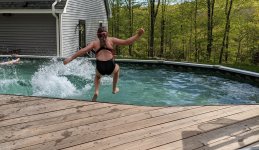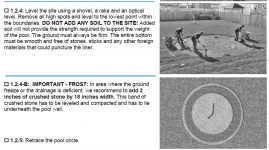Been reading lots of recommendations for ground prep on the forum and on the net (ex. Using pavers under each post, digging out the soil and backfilling with crushed limestone, levelling from the lowest point not backfilling and no pavers)
Looking for feedback from users with older installs. Have your pavers started heaving / ripped the liner? Has your pool settled at all? Has the limestone reacted with any metals on your frame / wall?
Currently planning on just levelling to the lowest point, no pavers - this is the recommendation from my pool manufacturer (Aqualeader) and pool supplier which also does installs.
thanks!
Looking for feedback from users with older installs. Have your pavers started heaving / ripped the liner? Has your pool settled at all? Has the limestone reacted with any metals on your frame / wall?
Currently planning on just levelling to the lowest point, no pavers - this is the recommendation from my pool manufacturer (Aqualeader) and pool supplier which also does installs.
thanks!



